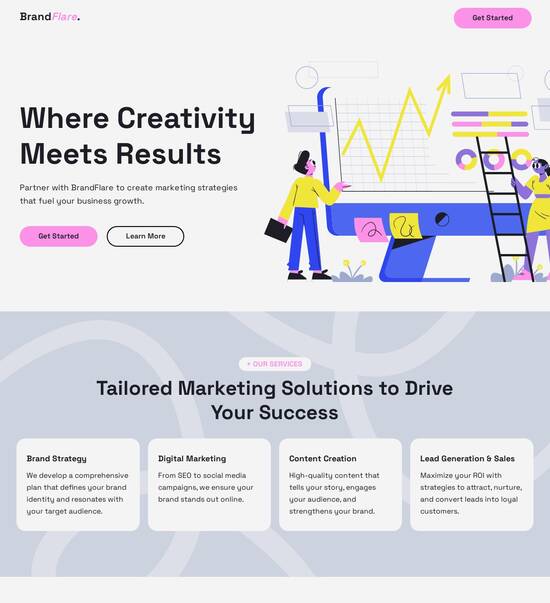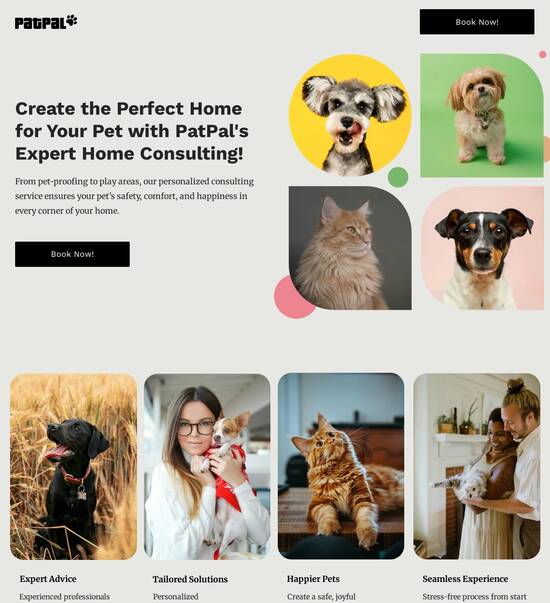
React.js optimized profile settings page template
Explore Similar TemplatesAbout template
Supercharge your profile settings page with React.js for outstanding performance! Learn more today.
Recommended templates

Easy to build without coding
With the intuitive drag-and-drop builder, anyone on your team can create high-converting pages without any knowledge of code or design. Make enhancements to your landing page with custom widgets using Javascript, HTML/CSS, or third-party scripts.

Multiple layouts for any industry and goal
Select from 500+ landing page layouts built to boost conversions across industry-specific scenarios. Customize them by adjusting fonts, adding images, and generating on-brand content with the AI assistant. Quickly scale with Instablocks® and Global Blocks that you can save, reuse, and update globally.

Loads fast and looks polished on any device
Every template is responsive, which means they present professionally on any device and load blazingly fast with our Thor Render Engine. You can also power them up with Google AMP technology to deliver an unparalleled mobile experience and drive higher conversions.

Robust analytics & experimentation
Get real-time updates and reporting across all your devices, showing the number of visitors, conversions, cost-per-visitor, and cost-per-lead. Launch AI-powered experiments, run A/B tests, and use heatmaps to analyze user behavior, then optimize your landing page to maximize conversions.







Easy to build without coding
With the intuitive drag-and-drop builder, anyone on your team can create high-converting pages without any knowledge of code or design. Make enhancements to your landing page with custom widgets using Javascript, HTML/CSS, or third-party scripts.
Multiple layouts for any industry and goal
Select from 500+ landing page layouts built to boost conversions across industry-specific scenarios. Customize them by adjusting fonts, adding images, and generating on-brand content with the AI assistant. Quickly scale with Instablocks® and Global Blocks that you can save, reuse, and update globally.
Loads fast and looks polished on any device
Every template is responsive, which means they present professionally on any device and load blazingly fast with our Thor Render Engine.
Robust analytics & experimentation
Get real-time updates and reporting across all your devices, showing the number of visitors, conversions, cost-per-visitor, and cost-per-lead. Launch AI-powered experiments, run A/B tests, and use heatmaps to analyze user behavior, then optimize your landing page to maximize conversions.
All the features you need to build react profile page template
Explore more featuresLearn how to build react js profile page template
Frequently asked questions about react settings page
Leading the way in building high-performing landing pages





Unlock the potential of your campaigns with Instapage's powerful landing page and CRO platform
Instapage empowers marketers to accelerate, optimize, and maximize ROI on digital marketing campaigns through its all-in-one landing page and conversion rate optimization platform. With access to over 100 high-converting templates and built-in lead generation elements, you can swiftly launch pages that capture leads and enhance your marketing strategy without the need for coding or developer assistance.
Exploring Instapage's Features
Instapage offers a user-friendly interface that simplifies the process of building landing pages with its library of conversion-focused layouts. Furthermore, its dynamic text replacement feature allows personalized content delivery to targeted audiences, ensuring that your messaging resonates with each user.
- Templates: Access a vast library of over 100 ready-to-use templates designed to boost conversions.
- Optimization Tools: Utilize built-in experimentation features such as A/B testing and detailed heatmaps to enhance landing page performance.
- Collaboration Features: Streamline page production with real-time feedback and editing capabilities, allowing for efficient collaboration with your team.
Step 1: Create Compelling Landing Pages
To start, choose a template that aligns with your campaign goals. Instapage’s intuitive builder will allow you to customize the layout, colors, and content according to your brand’s specifications, making it easy to create visually appealing and conversion-focused landing pages.
Step 2: Optimize for Conversions
Once your page is created, it’s essential to implement A/B testing to analyze which design or content variants perform best. You can use Instapage’s analytics dashboard to track key performance indicators and refine landing page elements accordingly.
- Test headlines and copy: Analyze what resonates more with your audience, adjusting headlines for impact.
- Optimize call-to-action buttons: Experiment with text and colors to determine the most effective combinations.
- Utilize heatmaps: Track user interactions on your landing page to understand where users are engaging and where they drop off.
Step 3: Personalize User Experience
With Instapage, you can deliver a tailored experience based on user data. Leverage dynamic text replacement to create personalized landing pages that speak directly to visitor interests, increasing the likelihood of conversions.
- Audience segmentation: Deliver targeted messages based on user demographics or behavior.
- Customizable content blocks: Adjust layouts and elements specific to user preferences.
- Data-driven insights: Use analytics tools to continually refine messaging based on visitor interactions.
Maximize the performance of your digital campaigns by utilizing the advanced features of Instapage. By focusing on creating landing pages that convert, optimizing their performance, and personalizing user experiences, you can drive better results from your digital marketing efforts.
Ready to enhance your landing page strategy? Start using Instapage today and unlock a suite of tools designed to amplify your marketing campaigns.
ReactJS optimized profile settings page template
Essential design principles of an optimized profile settings page
Creating an optimized profile settings page starts with understanding user-centric design principles. The profile settings page is often a critical touchpoint for users, making their experience fundamental to the overall application success. User-centric design emphasizes tailoring the interface and interactions to meet user needs, making accessibility paramount. Ensuring the page accommodates everyone, including those with disabilities, fosters inclusion and enhances overall user satisfaction.
Additionally, balancing aesthetic appeal with functionality is crucial. A well-designed profile settings page should not only look good but also serve its purpose effectively. Key principles such as simplicity, clarity, and efficiency should guide the layout and functionality. Simplicity reduces cognitive load; clarity ensures that users can easily navigate the settings, and efficiency allows users to complete their tasks quickly.
Optimizing load times and performance
Load times and overall performance are integral to the user experience. A slow-loading profile settings page can frustrate users, leading to higher bounce rates. Minimizing file sizes is one effective strategy to achieve faster performance. Compressing images and minimizing CSS and JavaScript files reduces loading times, creating a smoother interaction for users. Furthermore, adopting techniques like lazy loading aids performance by deferring the loading of non-essential resources until they are needed.
Using performance metrics such as time to first interaction (TTFI) and loading times helps track and optimize the experience further. Monitoring these metrics allows developers to identify bottlenecks and areas for improvement, ultimately leading to a more efficient profile settings page. Overall, keeping performance as a priority contributes to a more satisfying user journey.
Key components of a robust profile settings template
Several key components make up a robust profile settings template. Dynamic user data binding is essential in ReactJS applications. By leveraging state management tools like React's Context API, developers can efficiently manage and update user profiles in real-time. This approach ensures that profile changes reflect instantly across the application, providing users with immediate feedback.
Furthermore, organizing template files for better maintainability enhances overall development efficiency. It is important to establish a clear folder structure and create reusable components. For instance, components like buttons, input fields, and toggles can be designed once and reused throughout the application, reducing redundancy and improving consistency. High-order components (HOCs) also offer a way to enhance functionality and promote cleaner code.
Dynamic user data binding using React's Context API.
Organized template structures for maintainability.
Reusable components for efficiency.
High-order components for functionality enhancement.
Form handling and validation mechanisms
Form handling and validation mechanisms are crucial for optimizing user interactions on profile settings pages. Implementing controlled versus uncontrolled components allows developers to choose the best way to manage form inputs based on specific needs. Controlled components maintain form data in React's state, providing a consistent and predictable way to handle input. Conversely, uncontrolled components focus on direct access to the DOM, which can facilitate simpler integrations in certain cases.
For form validation, libraries like Formik and Yup have gained popularity for their ease of use and effectiveness. Integrating these libraries into the profile settings page ensures that user inputs are validated correctly before submission. Additionally, providing instant feedback on user input can significantly enhance the user experience by guiding users toward correct data entry, thereby reducing frustration.
Incorporating advanced technologies in your template
In today’s fast-evolving technological landscape, integrating advanced technologies into the profile settings page adds a competitive edge. React Hooks, such as useState and useEffect, simplify interaction management and data fetching. Employing these hooks optimizes side effects by ensuring that the component only updates when necessary, making the application more responsive. Developers can also create custom hooks for reusing logic across different components, promoting code reusability.
Moreover, managing complex states can be made easier by utilizing Prop Drilling and Context for global state management. Context API overcomes the common pitfalls of prop-drilling, especially in larger applications where multiple components need access to the same state. This practice streamlines state sharing, reducing the need for deeply nested props, and results in cleaner, more maintainable code.
Enhancing user experience with GraphQL
Incorporating GraphQL into ReactJS applications can significantly enhance user experience. It allows for efficient data fetching, enabling developers to retrieve only the data necessary for the profile settings page, thereby avoiding over-fetching. GraphQL queries facilitate the creation of a more tailored user experience, ensuring that only relevant information populates the profile settings page.
Using Apollo Client alongside GraphQL offers several advantages for state management, providing seamless handling of remote data. It efficiently manages local state and integrates with existing React state solutions. This powerful combination allows developers to focus on building user-centric features rather than handling data fetching complexities.
Implementing community-driven features
Community-driven features can add significant value to profile settings pages. Integrating elements such as team collaboration and user roles enables users to manage permissions and access levels effectively. This structuring is especially valuable in business environments where multiple users interact with the same profile settings. By designing these features with a community-centric focus, users can tailor settings to meet the collective needs of their teams.
Gathering user feedback is another essential aspect. By utilizing forms and polls, developers can engage users actively, gathering insights on their preferences regarding settings. Such interactions not only foster a sense of community but also guide future improvements based on user needs, leading to a more adaptable profile settings page.
Providing location-specific settings
Location-specific settings can enrich user experiences by personalizing interface content based on geographical data. Leveraging geolocation APIs allows developers to craft customized experiences tailored to users' locations. This customization involves implementing location-based defaults for specific settings, enhancing relevance and usability.
Additionally, adapting content to local communities is vital. This can include considerations for languages, cultures, and preferences based on regional data analysis. With user data driving adaptations, developers can create a genuinely localized profile settings experience that resonates with users.
Showcase and preview functionalities
Incorporating showcase and preview functionalities enhances user control over profile settings. Implementing live previews allows users to see the effects of their changes immediately, which fosters interactivity. Tools that simulate various device previews can provide insights into how profile settings appear across different platforms, ensuring a consistent user experience.
Furthermore, allowing users to manage and customize their portfolio display can elevate the overall experience. Integrating visual elements like drag-and-drop features for managing templates provides intuitive control. Users appreciate visual management tools, as they contribute to a sense of ownership over their profile settings.
File management and route setup
Efficient file management is crucial for a well-structured React application. Organizing template files effectively not only improves the development workflow but also enhances maintainability. A well-planned folder structure can facilitate teams in scaling the application while accommodating future updates to templates.
Routing techniques are also significant for enhanced navigation within the profile settings page. Implementing best practices with React Router enables seamless user navigation. Creating dynamic routes tailored to different user roles ensures that users have access to the appropriate settings, personalizing the experience while promoting security.
Addressing common questions and challenges
Common questions often arise regarding the navigation and customization of profile settings pages. Users may struggle with understanding how to modify their settings efficiently. It is crucial to anticipate these needs and provide clearly marked pathways through the interface, which can minimize confusion. An FAQ section within the settings page can also be instrumental in providing immediate assistance to users.
Troubleshooting common issues in template development is another area that requires attention. Employing techniques for debugging React components can illuminate state management issues that users may encounter. Additionally, contributing to community forums offers valuable resources for developers seeking answers to specific challenges, further establishing a culture of continuous learning.
Evolving templates based on user feedback
Establishing a methodology for continuous improvement based on analytics and user feedback ensures that profile settings pages remain relevant and user-friendly. By routinely collecting and analyzing user data, developers can identify areas for enhancement and iterate on existing templates accordingly. Such adaptability cultivates a responsive development environment that aligns closely with user needs.
Examining case studies showcasing successful iterations of profile settings pages can provide valuable insights. These examples highlight effective implementation strategies, revealing how user input led to refreshing changes that improved overall usability and satisfaction. The emphasis should always be on the user experience, ensuring the profile settings page evolves in tandem with user expectations.
Ready to skyrocket conversions?
Supercharge your ad campaigns with high-performing landing pages
Get started














